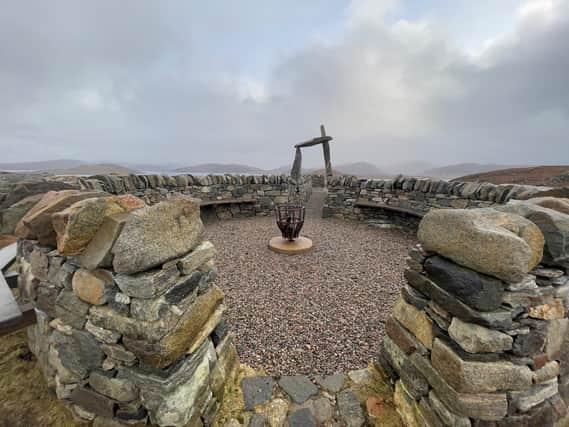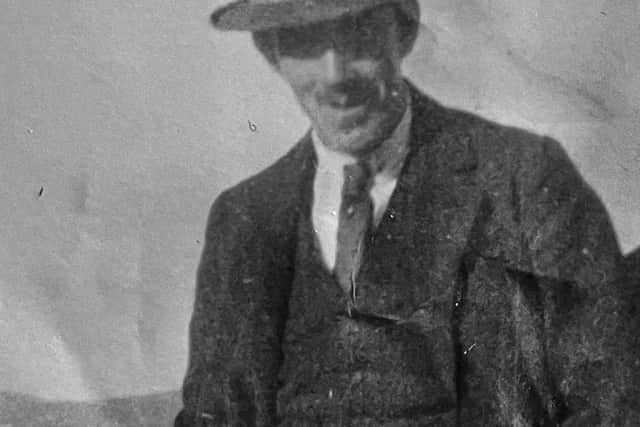Centenary of events that shaped present day


If ever the great Hebridean movie is made – as it should be – the title could easily be “1921”.
In normal circumstances, there would have been local events throughout the islands to mark the continuing relevance of this centenary year.
Advertisement
Hide AdAdvertisement
Hide AdPerhaps some will still be possible. One way or another, awareness of the struggles and hardships which shaped the places in which we live should be passed on to this and future generations.


The demand for farms to be broken up so that landless people could remain and survive ran through the islands. Eoligarry in Barra, Drimore in South Uist, Cheesebay in North Uist, Luskentyre in Harris, Galson in Lewis …. These and many more were the scenes of prolonged struggles for the means of subsistence which would allow people to remain in their own homelands.
The Land Settlement Act, passed in the final days of 1919, had created the framework for change. This was a radical measure – far more radical than anything that is likely to be attempted today.
It gave government the power to acquire land compulsorily or alternatively to force landowners to install tenants on land that was still in their ownership.
Advertisement
Hide AdAdvertisement
Hide AdThroughout 1920, frustrations and resistance grew across the Highlands and Islands in the face of obstruction and delay. The Board of Agriculture’s report in 1920 “feared that seizures in the north and west will increase in number and spread to other parts of the country unless a more rapid rate of progress is secured”. It was in 1921 that many of these matters finally came to a head.


That was certainly true in my own home area of Uig. As elsewhere, the demands for farms created by 19th century clearances to be broken up and distributed among the landless dated back to well before the First World War.
In 1914, 18 men were imprisoned in Edinburgh for raiding the farm of Reef, part of a prolonged struggle now commemorated by An Sùileachan memorial.
Only the outbreak of war led to the suspension of land agitation with most of the men away fighting for king and country. Promises were made of meaningful reform once the war was over and the Land Resettlement Act was a genuine attempt by the Coalition government of Lloyd George to address them.
Advertisement
Hide AdAdvertisement
Hide AdIn Lewis and Harris, however, the additional complication had emerged of Lord Leverhulme acquiring the island in 1918.
Leverhulme hated crofting and by late 1920 he and his supporters had successfully petitioned the Scottish Secretary to accede to a ten year moratorium on land re-settlement schemes in Lewis and Harris.
While his hostility towards breaking up farms around Stornoway is better known, it extended into every corner of the island, including Uig.
As delays continued and Leverhulme’s influence over government became the source of alarm, frustrations felt by the land-hungry cottars of Uig were expressed.
Advertisement
Hide AdAdvertisement
Hide AdIn a letter to the Board of Agriculture from John MacAulay, 3 Islivig, summed up the whole issue and the strength of feelings it gave rise to.
“The Government has no more need for us at the present time,” he wrote.
"We were thrown into the furnace against the foe, and by the foe. What do we find now? A warrant granting to put us in prison. The Secretary of State for Scotland said that the fact of Lord Lever and Co. buying the land changes the circumstances. We beg to ask in what respect?
“Both Lever and the present Government wants to keep us in bondage, no freedom, no land and no homes. We beg to say once and for all: until this burning question is settled there will be no rest in the Highlands and Islands.
Advertisement
Hide AdAdvertisement
Hide Ad"We pray to God that something will come about soon that will give us freedom, land and a home at a fair rent”.
Much heated debate was carried out through the letters columns of the Gazette.
Leverhulme and his supporters had organised the petition calling for a moratorium but “Uig Lewisman” condemned it as “a plot”, adding: “These people innocently gave their names in favour of industrial schemes and not against giving promised farms to ex-servicemen.”
In the event, and for reasons too long and detailed to recount here, the ten-year moratorium on resettlement lasted less than seven months before the Government accepted it was unsustainable in the face of continuing resistance in the crofting areas.
Advertisement
Hide AdAdvertisement
Hide AdFor Lewis, the turning point came when a senior officer of the Board of Agriculture, Thomas Wilson, arrived to find “a state of turmoil” and further land raids imminent.
Apparently acting on his own authority in Coll and Gress, he acted in favour of the ex-servicemen’s demand. By the time his superiors were informed, Wilson had “mapped out the holdings, selected his men by ballot, allocated the holdings and made agreement with the tenants”.
A letter of explanation said: “There was really no other way, if we were to avoid a situation that would have been embarrassing for the government”.
Much the same had happened in Uig and, with Dalbeg included in the same package, the tenants were given official occupancy of 57 new holdings at the start of the Whit term, 1921. Leverhulme had reluctantly agreed to these break-ups as part of the deal over the moratorium.
Advertisement
Hide AdAdvertisement
Hide AdWhen I spoke to an elderly Uigeach, Dolaidh Mhurchaidh Dhonnchaidh/Dolly Buchanan Afrin, in 2000 she recalled the turmoil of the period and Thomas Wilson visiting Breanish:
“Às dèidh a’ chogaidh, threabhaich iad Càirnis. Bha na màthraichean, bha iad cho tro chèile, ’eil fhios agad, le eagal dè bhathas a’ dol a dhèanamh riutha. An ann dhan phrìosan, na càite an deidheadh an cuir?
"Ach nuair a thàinig Wilson a bha seo, chuir e ar n- inntinn gu fois, agus thuirt e riutha nach leigeadh iad a leais a bhith a' worryigeadh tuilleadh, gu robh e a' shèirigeadh a-mach lotaichean Chàirnis dhaibh.
"Tha cuimhn’ m air, tha cuimhn’ m all right air, oh tha, agus cho aoibhneach ’s a bha m’ athair agus mo mhàthair airson gun d’ fhuair iad ceartas. Gun fhuair iad bìdeag fearainn is gun dèanadh iad bith beò, talamh airson a bhith a’ cur buntàta, vegetables is coirc, agus gum faigheadh sinn air beathaichean a thogail”.
Advertisement
Hide AdAdvertisement
Hide Ad(“After the First War, they started to plough Carnish. And the mothers were so upset, you know with worry. What would they do to them? Was it to prison, or where would they go?
"But when Wilson came, he put our minds to rest, and he told them not to worry any more because he was sharing out lots in Carnish for them.
"I remember it, I remember it alright, Oh yes and how happy my father and mother were because they got justice; they got a bit of land to make a living. Land for planting potatoes, vegetables and oats and where we could raise animals.”)
COTTARS from Breanish and Islivig were re-settled in the village of Carnish.
Advertisement
Hide AdAdvertisement
Hide AdThose from Aird and Kneep were settled in Ardroil while others from Valtos, Kneep and Crowlista became established in Reef and Timsgarry.
At long last, the summer of 1921 marked the end of a remarkable and often heart-breaking struggle for justice, land work and homes to raise young families.
In an article for Uig News, to mark the centenary of Ardroil, Anna MacKinnon recalled that her father “being available and very familiar with the terrain” had helped with the marking out of the new crofts.
He warned the surveyors, who started at each end, that they were making them too large and would run out of land.
Advertisement
Hide AdAdvertisement
Hide AdA long lunch at Uig Lodge made them “even less sensible than in the morning. The result was that, when they met after measuring out 13 crofts from either end, there was little land left for the middle one which is why no. 7 Ardroil is small with little arable ground”.
Down to that degree of detail, the conclusion of these events shaped Uig as we know it in the present day.
Land which was broken up into crofts still holds population, however fragile. Land which stayed outside crofting tenure has never subsequently been brought within it.
Recent research showed that, of the six crofts formed in Carnish, one remains with the original family.
Advertisement
Hide AdAdvertisement
Hide AdSix of the 14 crofts in Ardroil are tenanted with descendants of the same families. In Timsgarry, the figure is four out of eight.
Reef, the largest of the re-settled villages with 15 crofts, has five tenanted by their descendants.
Perhaps most poignantly, the Valtos peninsula where so much of the struggle took place, is now under the ownership of its own community.
Without the struggles in the early part of the 20th century, the strong likelihood is that these places would be as empty of people as other parts of the parish which were never repopulated. The same story repeats itself throughout much of Highlands and Islands.
Elsewhere, the struggle continued.
Advertisement
Hide AdAdvertisement
Hide AdGalson was the last substantial farm on Lewis to be broken up. This eventually happened in January 1923, still against Leverhulme’s opposition, after the Treasury had been advised by the Board of Agriculture that “the district is dangerous”. Galson too is now under community ownership like South Uist, most of Harris and large areas of Lewis.
In all these places, the people who live there – whether recent arrivals or tenth generation natives – owe much to the men and women who had the courage to fight for the right to remain, a century ago.